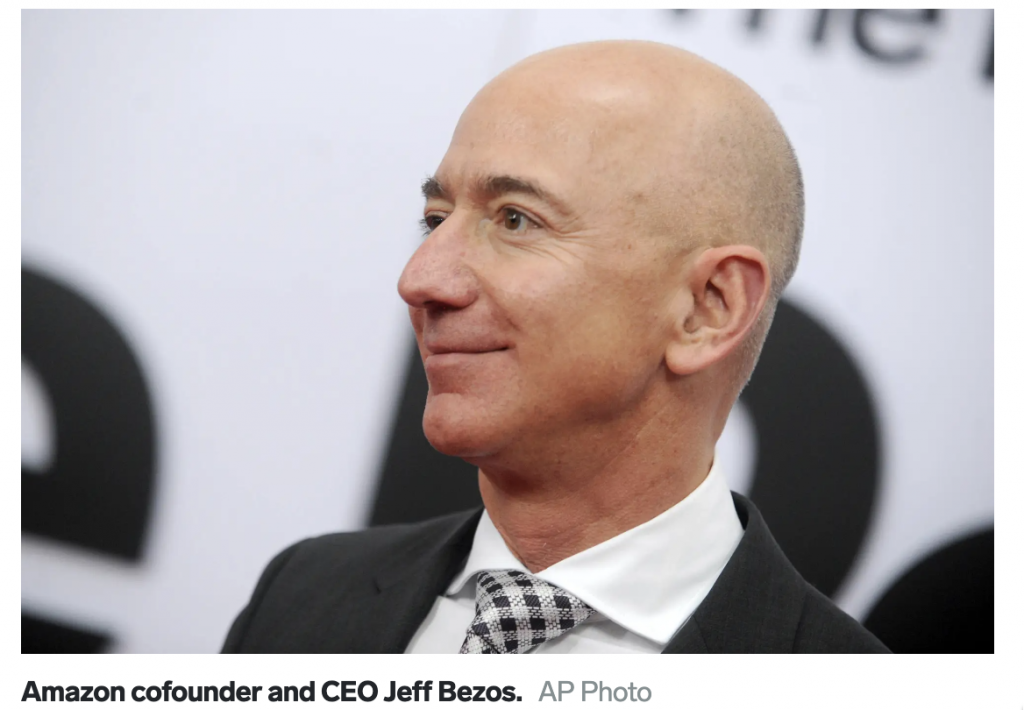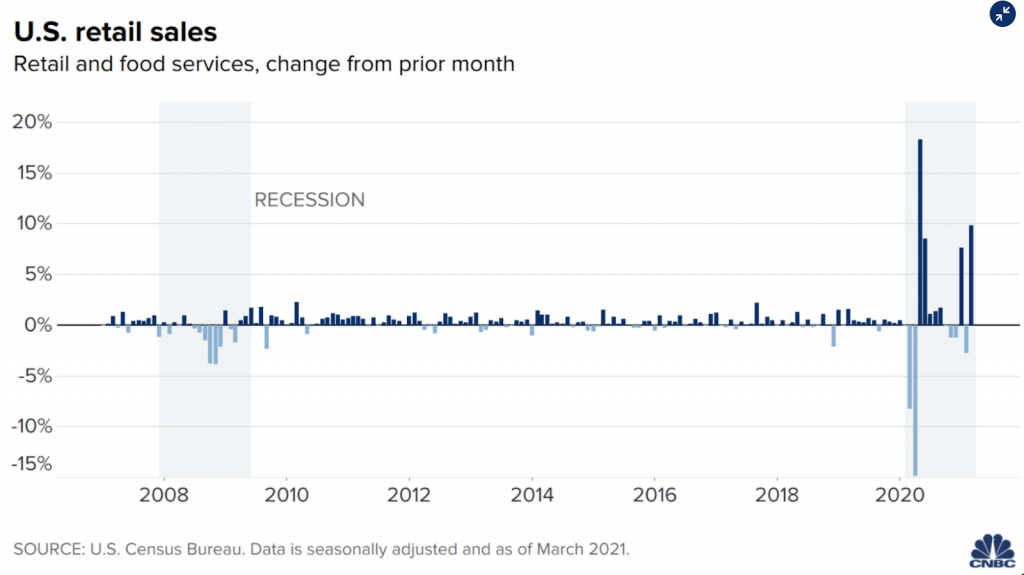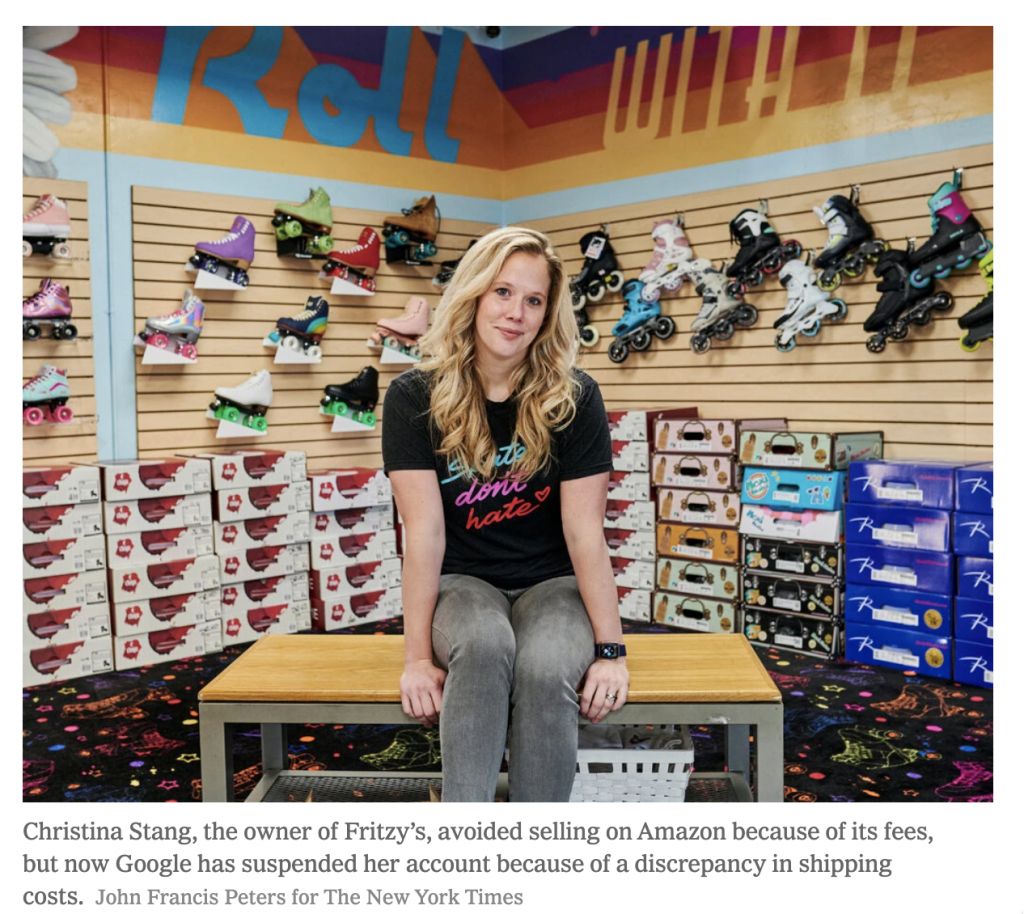Archive Monthly Archives: April 2021

The 80/20 of Ecommerce – April 23, 2021
Jeff Bezos’ Final Amazon Shareholder Letter – My personal takeaways
Jeff Bezos the founder and CEO of Amazon will be stepping down soon. Each year he writes a highly anticipated newsletter for Amazon shareholders.
This week he shared his final Amazon Shareholder newsletter to give us a glimpse of some of the key concepts he instilled since he founded Amazon in 1997 and his future outlook for the company.

If you have a few minutes I recommend you read it here.
Here are a few of my personal takeaways:
“Create More Than You Consume
If you want to be successful in business (in life, actually), you have to create more than you consume. Your goal should be to create value for everyone you interact with. Any business that doesn’t create value for those it touches, even if it appears successful on the surface, isn’t long for this world. It’s on the way out.”
“How about third-party sellers? We have an internal team (the Selling Partner Services team) that works to answer that question. They estimate that, in 2020, third-party seller profits from selling on Amazon were between $25 billion and $39 billion, and to be conservative here I’ll go with $25 billion.”
“We save customers time.
Customers complete 28% of purchases on Amazon in three minutes or less, and half of all purchases are finished in less than 15 minutes. Compare that to the typical shopping trip to a physical store – driving, parking, searching store aisles, waiting in the checkout line, finding your car, and driving home. Research suggests the typical physical store trip takes about an hour. “
Being Distinct is not easy
“We all know that distinctiveness – originality – is valuable. We are all taught to “be yourself.” What I’m really asking you to do is to embrace and be realistic about how much energy it takes to maintain that distinctiveness. The world wants you to be typical – in a thousand ways, it pulls at you. Don’t let it happen.
You have to pay a price for your distinctiveness, and it’s worth it. The fairy tale version of “be yourself” is that all the pain stops as soon as you allow your distinctiveness to shine. That version is misleading. Being yourself is worth it, but don’t expect it to be easy or free. You’ll have to put energy into it continuously.”
Virtual Canton Fair is happening now
If you’re looking to source products from China beyond searching on Alibaba, check out the online Canton Fair happening from April 15-24, 2021.
With China’s borders still closed to foreigners, this is the only way to attend the Canton Fair, which is the largest trade fair in China.
Their website is a little clunky and requires registration though.

3PL warehouse growth not welcome in some California communities
As ecommerce continues to grow, there is a boom in demand for warehouse space near consumers according to Supply Chain Dive.
“Warehouse demand exceeded supply in Q4 of 2020 and early 2021. The national vacancy rate fell to 4.8%, according to the Industrial Business Indicator from Prologis.”
However, some residents in cities such as Upland, CA are pushing back as they do not appreciate the additional traffic jams and pollution from lines of trucks coming and going from these warehouses.
The city council is considering modifying zoning regulations to put limits on the size and permits required to open and run warehouses.
How to create an Amazing (Amazon) Listing: listing optimization contest, powered by PickFu
This was a really cool competition where 4 agencies competed to create the best Amazon product listing. This event was hosted by PickFu and judged by Kevin King and Karyn Thomas.
This was a great look at the fundamentals of the visual parts of an Amazon product listing including the Main Image, Lifestyle Image, Infographics, and Product Video.
And even better was the fact that these agencies used split testing powered by PickFu to find out which images/videos people liked the most.
Check out the replay here to find out who won!

By the way, a few months ago, Anthony Cofrancesco from PickFu held an advanced Amazon Listing Optimization and Split testing workshop. It’s a paid workshop and if you purchase for $50 you will get $50 PickFu credit (essentially it’s a free training). Learn more here.
Live Training 4/26/21 7pm EST: How to Crush it on Amazon FBA in 2021
2021 is going to be huge in Ecommerce and especially on Amazon.
I’d love to invite you to an exclusive training next week where I will walk you through how to crush it on Amazon FBA in 2021.
- A WALKTHROUGH of the Roadmap to selling on Amazon FBA in 2021
- What’s changed so far in 2021
- What’s not working anymore (so you don’t waste your time)
- Answer your questions LIVE
This will be a free live webinar hosted by yours truly.
Live Training
The Roadmap to Building an Amazon Private Label Business in 2021
Monday, April 26th, 2021 at 7:00pm EST
REGISTER here: https://forms.gle/ZFUnU6UkkRzN73Jt7

The 80/20 of Ecommerce – April 16, 2021
Retail sales explode in March as consumers use stimulus checks to spend heavily
In the US, retail sales “exploded” in March mainly due to the $1,400 stimulus checks issued by the government.
According to CNBC, “Sporting goods, clothing and food and beverage led the gains in spending and contributed to the best month for retail since the May 2020 gain of 18.3%, which came after the first round of stimulus checks.”
Furthermore, the outlook for 2021 seems very rosy as government stimulus is expected to inject a growth serum into the arm of the US economy.
Some experts are predicting that this will be the “fastest economic acceleration in nearly 40 years.”
But the long-term outlook once the economy weans itself off the government checks is less clear.
All in all, I expect a strong year for ecommerce as the economy rebounds.

Consumer Prices in U.S. Rise by Most in Nearly 9 Years
If you’re in the US, you may have already felt this – A price hike on almost everything!
US consumer prices rose the most it’s risen in 9 years this March. This was mostly due to reopenings after the Covid-19 lockdowns.
According to Bloomberg: “Goods prices rose 4.1% in March from a year ago, services up 1.8%”
In addition “Car and truck rental prices rose 11.7% from a month earlier, most since June, while year-over-year increase was largest on record. Food prices climbed 0.1% from a month earlier, while energy costs jumped 5% in the biggest gain since September 2017.”
Another key reason for the price increases are COST INCREASES.
According to a study by the Institute of Supply Management, “more than half of service providers reported paying higher prices in March, the largest share since 2011. The ISM’s manufacturing survey showed about 72% of manufacturers said the same — the second-most since 2008.”
What does this mean for ecommerce sellers?
If you’ve been feeling the pinch in your supply chain (rising product costs, shipping bottlenecks, additional 3PL costs, tariffs, etc) this may be a valid reason to raise your prices if you haven’t already.
Profitability is one of the key factors that keeps businesses in business so as the rest of the economy is raising its prices it may make sense to adjust your pricing (within reason) now.

Here are some things you may have missed from earlier this month:
- Amazon PPC Surpasses 10% of U.S. Digital Ad Market Share
- Amazon Is the Target of Small-Business Antitrust Campaign
- When should a brand go through a broker, PE firm, or buyer for a sale [Video training]
- The Simple 3-Step System to Transition from Operator to Owner in your Amazon Business [Video Training]
- The 7 Deadly Sins of Amazon & Ecommerce Sellers Webinar Replay – Private Label Live [Video Training]
- “How to sell $30-100K+ in pre-orders before ordering inventory” – Webinar about getting pre-orders and List Building with Vance Lee [Video Training]

The 80/20 of Ecommerce – April 9, 2021
Amazon PPC Surpasses 10% of U.S. Digital Ad Market Share
According to The Wall Street Journal, “Amazon. com Inc.’s share of the U.S. digital ad market grew to 10.3% last year from 7.8% in 2019, according to a new report from research firm eMarketer.”
This means that Amazon PPC which includes its Sponsored Products, Sponsored Brands, DSP and other advertising platforms is growing tremendously.
Though representing a smaller market share than Facebook and Google ads, it is growing more quickly as a sign of its increasing importance in the ecommerce world.
eMarketer estimates Amazon’s U.S. ad revenue last year grew to $15.73 billion, up 52.5% from 2019. Amazon’s U.S. digital ad share is still small relative to Google and Facebook’s, which accounted for 28.9% and 25.2% of the business, respectively, in 2020.

Amazon Is the Target of Small-Business Antitrust Campaign
Is Amazon becoming a monopoly?
Last Tuesday, a new coalition of US small business groups launched a campaign for tougher US antitrust enforcement, specifically calling for the breakup of the biggest online commerce, Amazon.
This group includes the American Booksellers Association, National Grocers Association, and a number of local and regional business organizations.
Their goal is to enact policy that could separate Amazon’s retail product business from its online marketplace of FBA sellers.
Will Amazon FBA sellers see the day where it no longer will need to compete against Amazon Basics in-house brands? We will see what happens!

Amazon DSP Live Webinar (Free) – Presented by GETIDA & Buy Box Experts – 4/13/21
Our friends at GETIDA will be hosting a free webinar on Amazon Demand Side Platform (DSP). This will be useful for larger Amazon FBA sellers who are already spending a lot on Amazon PPC.
According to Amazon, “The managed-service option (DSP) typically requires a minimum spend of $35,000 USD (minimum may vary per country)”
If you are in the ballpark and would like to learn more about Amazon DSP, I recommend this free webinar on April 13th to learn:
– What is Amazon DSP?
– What is the opportunity for Amazon sellers?
– How can Amazon sellers use DSP to get a real edge and advantage over their competitors?
– How can Amazon sellers retarget sponsored ads to shoppers who visited their listings and improve the overall ROI on ad spend?
– Can Amazon sellers convert the traffic of their competitors and gain new customers?
Sign up here: https://us02web.zoom.us/webinar/register/2916155736759/WN_q_7WoibBQhqCNhzqcTFP0Q

When a brand should go through a broker, PE firm, or buyer for a sale[Video training]
Before you sell your business, it makes sense to know who you can sell it to.
That’s why I invited Kevin Flaherty, Thrasio’s Manager of Acquisitions to give you a rundown of the possible buyers for your Amazon FBA business.
Kevin has been involved in a number of Amazon acquisitions and has a wealth of experience in sourcing, evaluating, and negotiating acquisition deals.
In this 60 minute training, you will learn:
- [7:54] Who’s who Brokers, Aggregators, PE firms
- [10:00] Major differences between them
- [12:51] What is SDE and EBITDA?
- [18.48] Who should you go to? Brokers Pros and Cons
- [23.43] Aggregators Pros and Cons
- [30.33] Importance of building SOPs
- [35:49] Private Equity Pros and Cons
- [39:15] Which type pays the most?
- [40:36] What “multiples” are currently used to buy Amazon seller business?
- [43:06] Charitable causes – e.g. 10% proceeds support a charity – will this hurt or help my sale?
- [44:56] **Social media – how much extra money does social media bring to the sale.
- [46:59] What is the optimum time for selling an Amazon business and the key points to consider in taking this decision?”
- [51:41] Multiple brands within a larger business – positive or negative?
- [52:43] Opinion on Lawyers
- [55:57] How important is it for sellers to have additional off-amazon sales

As a bonus, Thrasio is offering a free consultation to help answer any questions you have about selling your Amazon FBA business. You can book a time with them here: https://bit.ly/3fUB63j
Also checkout Private Label Live to learn more about exiting your Amazon business and a chance to get your questions answered on their live show.
Successful Sellers, Entrepreneurs, and Ecommerce experts in Season 3 every Friday, 1pm EST / 10am PST: https://connect.thras.io/private-label-live
Here are some things you may have missed from last week:

The 80/20 of Ecommerce – April 2, 2021
Google vs Amazon: Google is challenging Amazon in the game of E-commerce
In the game of ecommerce, Amazon is the 800lb gorilla. It generated $295 billion through it’s FBA program in 2020.
By comparison the amount of products people purchase on Google is tiny. It’s estimated at only about $1 billion according to Marketplace Pulse.
But I wouldn’t rule out Google just yet because it is one of the most powerful companies in the world. AND it does have a few factors that benefit sellers.
First is lower costs. Since last year, Google has allowed sellers to list their products for free and commission free on Google’s shopping site.
Amazon fees can be quite hefty in comparison. Many sellers budget upwards of one-third of their selling price to pay for Amazon fees which include fulfillment fees, storage fees, and commissions.
Secondly Google allows sellers to have more control over the shopping experience. Google allows sellers to drive traffic and customers directly to your own website or Shopify store. You can get their names, addresses, email addresses, telephone numbers, and you can pixel them, etc.
Selling on Amazon FBA in contrast means you will not get any customer data besides a customer’s name. Email addresses, addresses, and telephone numbers are a no-no in Jeff Bezos’ playbook. These customers belong to Amazon (not you).
All is not rosy selling on Google however as some sellers report that Google will suspend sellers for reasons such as a “discrepancy in shipping costs”.

But in reality Google still has a long way to go to catch up with Amazon.
Amazon shopping is ingrained in online consumer behavior. Many people visit Amazon FIRST when they want to buy something.
But it will be interesting to see if Google can make a dent in the ecommerce game that continues to heat up in 2020.
Covid-19 has changed online shopping, Corona Virus is impacting E-Commerce.
Most people nowadays prefer to shop online because they believe it’s safer than shopping for the goods in physical stores, which of course increased the sales of online sellers.
We all know that shopping habits changed. Everyday, more retailers are switching to online selling and a lot of entrepreneurs are starting with their ecommerce ventures.
However what will happen after the pandemic subsides?
According to The Harris Poll, “overall, consumers are still more likely to shop in-store after the pandemic resolves, that is, after all COVID-19 restrictions have been lifted.”
Does this mean that e-commerce will experience a large drop after the pandemic?
What do you think? Comment below and let me know.

The Simple 3-Step System to Transition from Operator to Owner in your Amazon Business [Video training]
As you build, grow, and scale your Amazon business, one of the biggest bottlenecks to growing your business is doing everything yourself.
In a recent poll of 7 Figure Sellers, the number mistake they admitted was HIRING TOO LATE.
That’s why I invited John and Brian from Seller Candy to give you a training on the 3-Step System to Transition from Operator to Owner in your Amazon Business
In this 60 min training you will learn:
- [12:19] Why your assistants must be experts
- [25:38] How to solve a listing suspension with Seller Central
- [28:37] What if it doesn’t work?
- [30:00] Breakdown of the process
- [32:00] The one powerful trick how to solve listing suspensions with seller central
- [34:09] Amazon GAP report

If you’d like to outsource this to Seller Candy to have an experienced Amazon VA step in right away to help you with your Amazon business, you can learn more here: https://signup.sellercandy.com/7FSS
Please note I use Seller Candy and am an affiliate so if you do join through the link above, I will receive a commission which helps pay the bills and my coffee! Thanks!
And they have 3 special bonuses and a 30-day money back guarantee if you’d like to test it out. https://signup.sellercandy.com/7FSS
